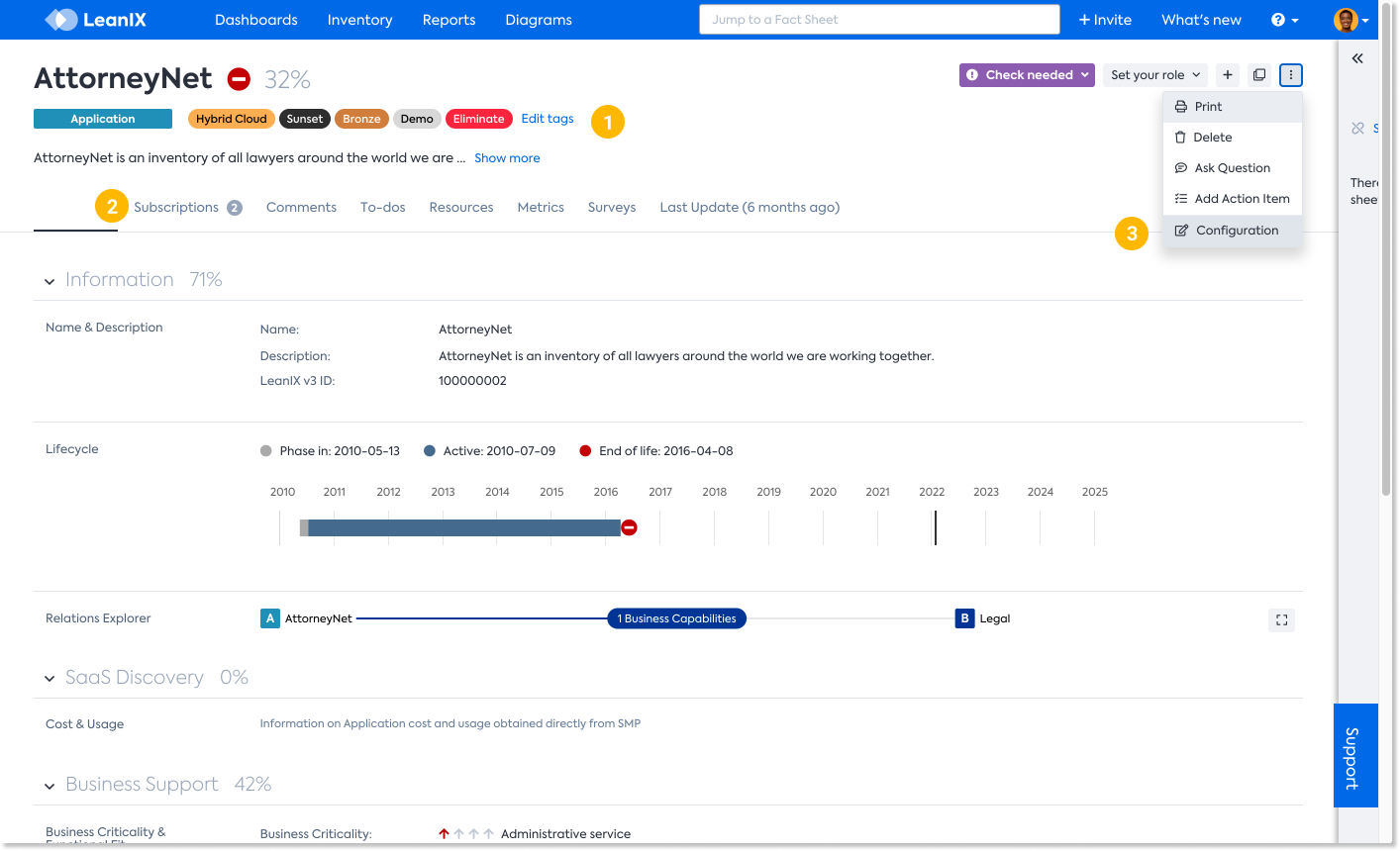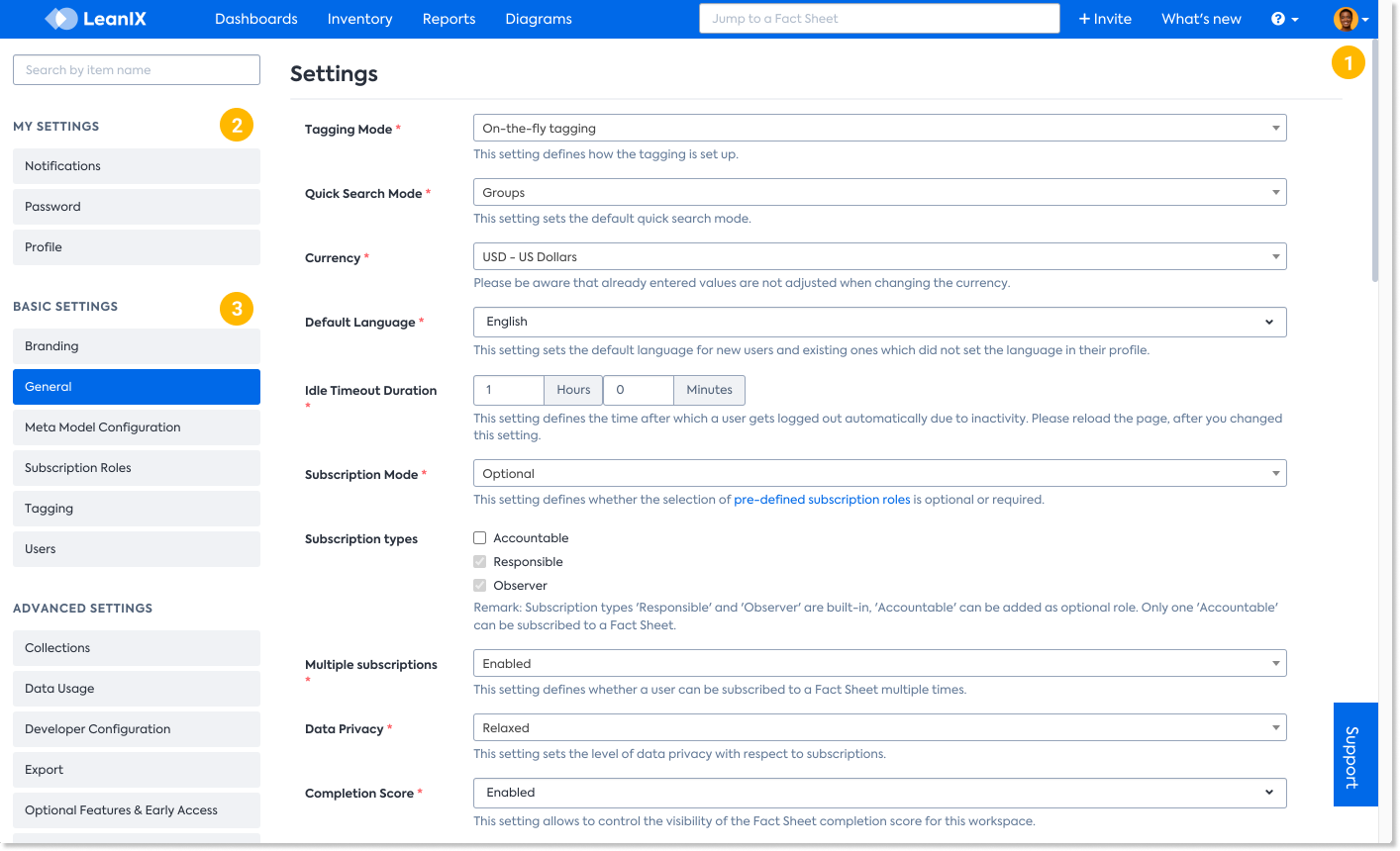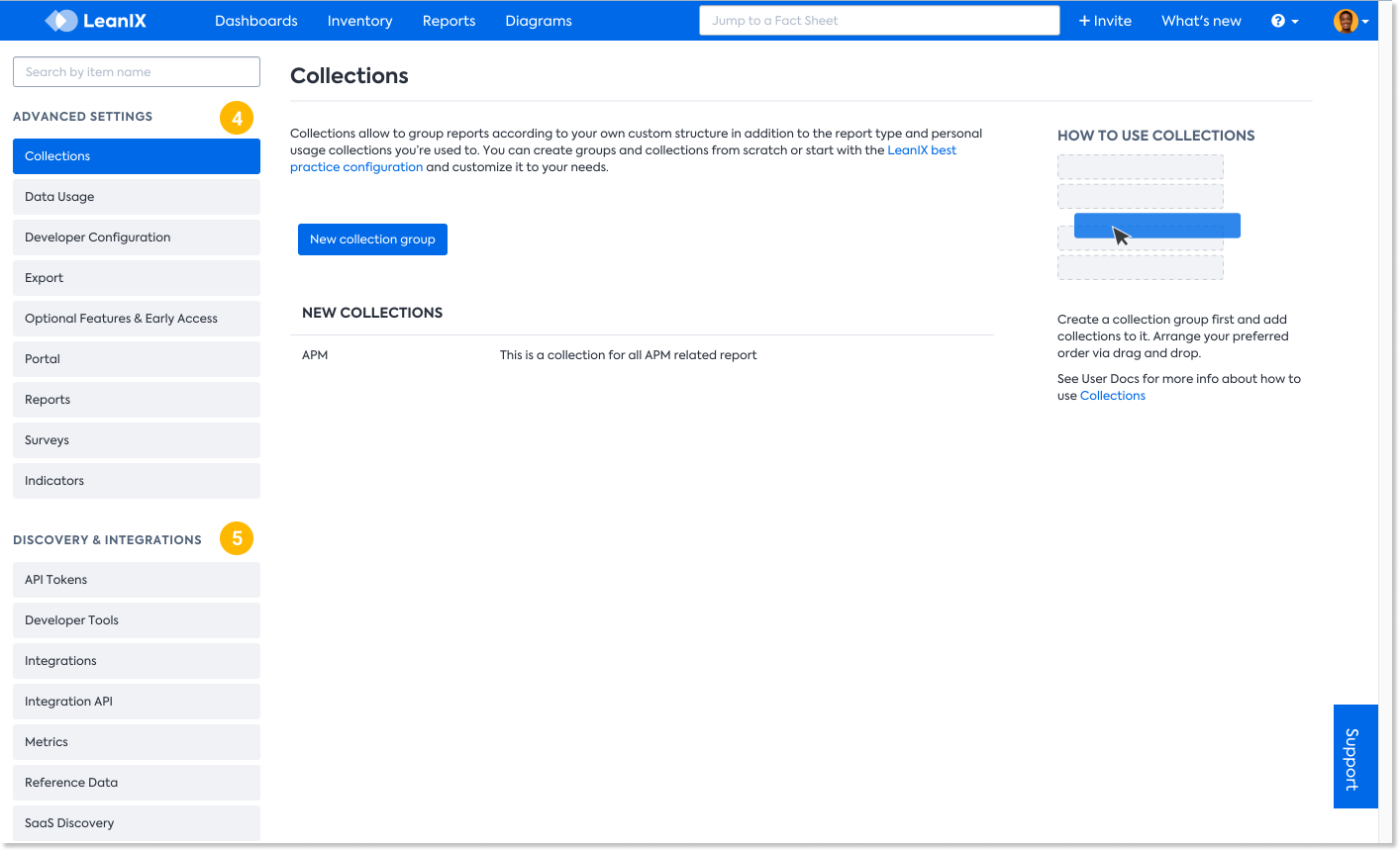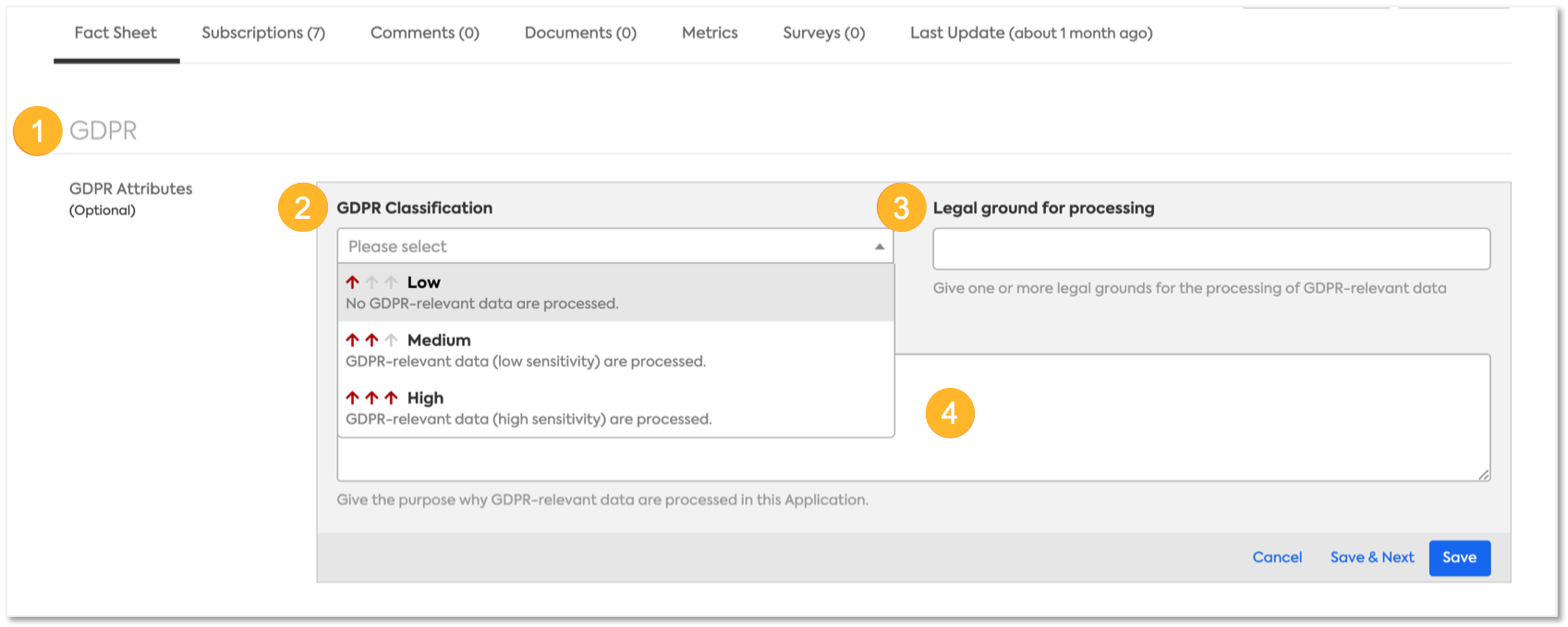Configuration Summary
LeanIX offers various opportunities for the solution to be tailored individually to an organization's need. This page gives you an overview on what is possible through self-service as well as with the support of the LeanIX Team.
Self-Service
Information
Most self-service options are available to all LeanIX customers, but some are edition-specific. Please reach out in case of doubt.
Individualize the appearance of a single Fact Sheet
As a LeanIX administrator, you have the following options to individualize the way your users work with a Fact Sheet:

Encourage the usage of Tags: Tags are a great way to track and filter requirements which are not already in a Fact Sheet. Every user can create their own tags, while an Administrator can create tag groups.
Use the following link to learn more about Tagging.
Bring your own Subscription Types: Use role definitions (e.g. Application Owner, Software Architect) that are known by everyone in the company.
Configure the shown sections and attributes: Control what information is shown, and whether it is considered as mandatory for the completeness of the Fact Sheet. Set the weight of sections to "1" to treat them as mandatory, or to "0" for optional.
Learn more about Fact Sheet Completeness here: Data Quality Management
Best Practice
Especially in onboarding, it is helpful to hide all sections that are not in use. This allows users to focus on the required information. It is safe to hide a section - no data is removed, it is even still accessible via the API.
Configure your LeanIX workspace
As an Administrator, you cannot only edit the appearance of a Fact Sheet, but many other settings in self-service:

The Administration area is always accessible via the drop-down at the top right.
Every user - not only administrators - can update their profile, change their password and control their notification settings.
In Basic Settings, you can configure Fact Sheet in the Meta Model Configuration, control settings like Tagging,User, and Subscription roles, and even set your own Logo & Color in the Branding tab.

In the Advances Settings, you can access configuration for Surveys, Metrics, and more.
For developers and integrations, you find several tools here as well.
Information
You can find more information at Administration Overview.
Configuration Add-Ons
In addition to the Self-Service configuration, the Configuration Add-Ons allow you to modify the data model, fact sheet appearance, labels & descriptions, permission model and much more. The configuration is executed by LeanIX Customer Success.
License information
Depending on your edition, different Configuration Add-Ons are available. Please reach out to learn more.
When to use the Configuration Add-Ons?
LeanIX comes with a Best practice data model that is well-aligned to all typical Enterprise Architecture use cases. The premise of Configuration Add-Ons is not to create an entirely new data model, but rather to tweak it such that it fits perfectly with your organization's use cases and requirements. The following table show typical goals and how to achieve them.
| Goal | Example | Description |
|---|---|---|
| Improve Usability | Reduce the number of tags | Tags are a powerful instrument to bring own information to LeanIX. Usability degrades however when too many tags are used (more than 5-7 per Fact Sheet). The Configuration Add-Ons allow you to turn certain tags into attributes - see Modeling Guidelines on Application vs. IT Component |
| Use explicit relations | Besides the best-practice data model, LeanIX allows you to use requires/required by relations to connect Fact Sheets, e.g. Processes to Interfaces. As these relations are not explicitly defined, usability decreases when using them too often. The Configuration Add-Ons allow you to evolve them into regular relations, such as the standard relation between Applications and Business Capabilities. | |
| Fine-tune data completeness | On the best-practice data model, LeanIX allows you to define sections as mandatory or optional for Fact Sheet completeness. With the Configuration Add-Ons, you can fine-tune this to the level of each attribute. | |
| Support new Use Cases | GDPR | GDPR is a great opportunity for EA, as it requires a high data quality with regards to the Applications, Data Objects and Interfaces of an organization. The Data Protection Officers often have a highly specialized views on their requirements and Configuration Add-Ons allow you to further support these views without decreasing the general usability. |
| IT Service Management | In many companies, the concept of a Business Service is established to bridge the gap between Business Capabilities and Applications. LeanIX customers have found ways to bridge the gap within the existing data model (e.g. use an Application with a tag "Business Service", use a third-level Business Capability as Business Service), but especially when considering an integration with an ITSM system like ServiceNow, it makes sense to consider a dedicated "Business Service" Fact Sheet. | |
| Advanced IT Architecture Management | Customers use the IT Component Fact Sheet to address use cases like Technology Stack - Reference Models and Cost Management. For this, the standard model of IT Component, Tech Stacks and Providers works great. Customers often like to bring more dimensions of their IT Architecture into LeanIX, e.g. instances or platforms, to address use cases like Microservices or Container Management. Here, usability can suffer quickly from an overcrowded IT Component Fact Sheet, and it makes sense to consider configuration e.g. a dedicated "Environment Fact Sheet". | |
| Tweak Permission Model | Special roles | LeanIX helps organizations establish a vivid, open collaboration with their IT landscapes however there are instances when organizations balance this openness by deliberately introducing exceptions, e.g. allowing only some users to see costs or classified content- or - allowing a data protection officer to have the sole accountability to set a certain approval. In this case, the Configuration Add-Ons can help enhance roles or permissions. |
| Working with sub-organizations | In large companies, it is often desirable to create an open exchange, but the road towards this goal is long. If your company consists of sub-organisations that are not (yet) allowed to share certain content, the Configuration Add-Ons may help bring this information into a shared workspace while continuing to maintain a clear delineation. |
Concrete example
The following screenshot shows a simple configuration to address the GDPR use case. Within the Application Fact Sheet, a new Section called GDPR is created. The included attributes are handled the same as other attribute in LeanIX.

How does it work?
Please see the guide on Meta Model Configuration and the Meta Model documentation for more details on the Meta model.
FAQ
Q: Why can't I just reuse an existing Fact Sheet Type for another purpose (e.g. use the Provider Fact Sheet which is not in use to model a Business Service)?
A: The existing Fact Sheet Types are highly specialized to serve their role in the Best Practice Data Model and for the supported use cases. Certain reports rely on out-of-the-box dependencies. Hence, you run the risk of seriously confusing your users when misusing the existing types.
Q: Why is configuration not available in self-service?
A: The adaptions allow powerful modifications on the data model that might cause data loss or legal violations if used in the wrong way. As LeanIX is responsible for the data integrity and quality of service, these modifications can currently not be executed in self-service.
The Configuration Process
With the configuration process, we try to respond to the needs of all of our customers. Therefore, this is a manual process that requires in some cases significant effort on the side of LeanIX. To move along with your request as fast as possible we have created a standardized process to collect requirements, develop and test your configuration.
1. Check if your requirements can be implemented through Self Configuration
Please check out our guide on Meta Model Configuration which changes can be made by yourself directly in your workspace.
2. Sending a request and requirements tracking
The most time-consuming part of the process is the tracking of requirements. Out of past experiences, most requests come with missing information and this then leads to a lot of back-and-forth communication which slows down the process of your request. To avoid this we have condensed the needed information into requirements templates for different use cases which we provide for download below.
Sending in a request (Templates)
You may reach out to support at LeanIX Support or reach out for the configuration requests. Please discuss any requests that go beyond the creation or alteration of a single field with your CSM. They are prepared to discuss the use case as well as propose implementation options.
When sending a request please make sure to add the respective template as an attachment and state the live workspace name for which this should be implemented.
Use this template for all requests that are not covered by Self Configuration
If you are discussing the alteration of the authorization model please talk to your CSM.
For all other requests, an email with the specifications will be fine.
3. Workspace preparation
For the development, LeanIX can set up a dedicated test workspace (sandbox) in which we import the latest state of your live workspace. This way we can provide optimal testing conditions.
Important
- This workspace will be overwritten regularly before any major development by us, so any changes made to the data here will be lost.
- From August 1, 2022, if you require sandbox workspaces as an add-on, you can request it to your dedicated CSM. Sandbox workspaces are available as a paid feature for new contracts.
4. Staging
Once a request is received and correctly specified, our engineers have four weeks' time to develop the first iteration of the configuration. They will contact you with the result and give you the chance to provide feedback.
5. Go Live
If you are happy with the changes we will move the changes to your specified live workspace. If possible we always try to complete the process for one request before we start a new configuration request. This way we can efficiently handle the code and avoid delays in the development.
Updated 10 months ago
